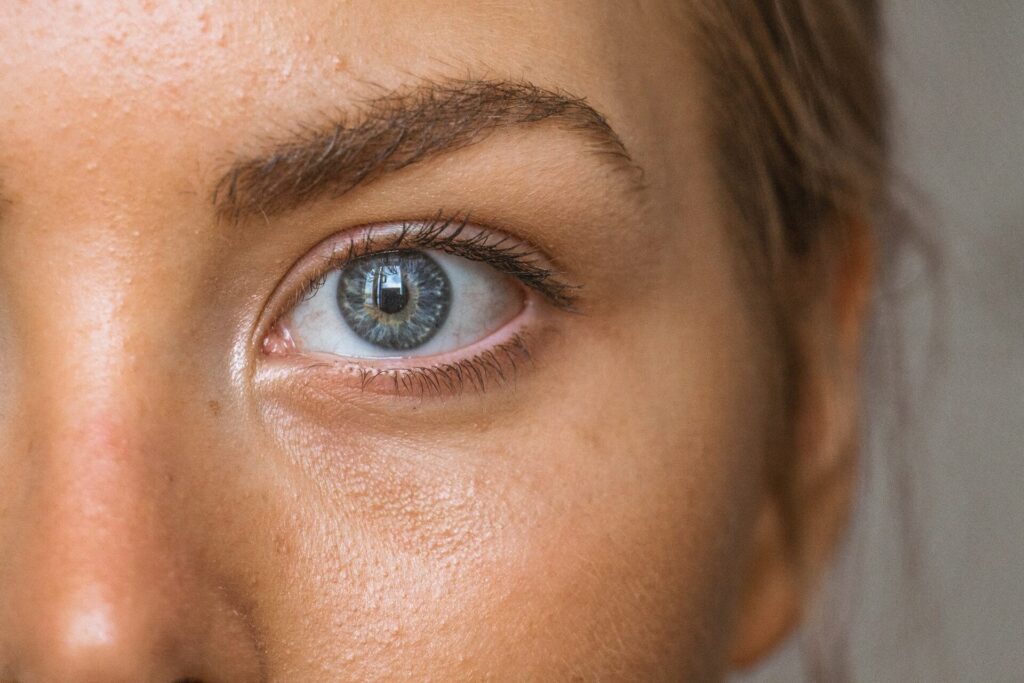
Body + Mind is reader-supported. We may earn an affiliate commission when you buy through some of the links on our site.
While you can expect flashing lights at a concert and wavy lines in your field of vision during a heatwave, these visual changes on their own can signal an ocular migraine. Colloquially known as a “light show” with people who experience them, ocular migraines produce shimmering lights, zig-zag shapes and blurred vision. Sounds familiar? Here’s what you need to know about ocular migraine symptoms and when to get help.

Ocular migraines are different from migraines because they produce visual disturbances without a headache. While a headache may follow after, the actual visual disturbance has no pain. They can also be part of the aura before a migraine attack.
Medical definitions divide ocular migraines into three types:
Most people who experience ocular migraines describe flashing lights and blurry spots in their vision. You may feel temporarily incapacitated and experience difficulty with motor control.
Retinal migraines are more rare than painless ocular migraines. They only occur in one eye. If you experience temporary blindness or a sudden diminishing of vision, seeking help is essential.
Auras are visual disturbances that occur just before a migraine headache. They last between five minutes to an hour and may go away without medical treatment. Most say that it feels like looking through a cracked window or kaleidoscope.
Aura starts in the brain and occurs in both eyes. With an ocular migraine, blurred and distorted vision may only happen with open eyes. With an aura, you will see bright spots or flashing lights, even with your eyes closed. You will also feel other sensory symptoms like tingling in your body, numbness or confusion.
Sometimes, people don’t see auras at all but begin to experience light sensitivity with pain and pressure behind their eyes.
Ocular migraines occur when the blood vessels at the back of your eye in the optic nerve swell and tighten. This produces visual disturbances.
You may see or experience some or all of the following with an ocular migraine:

Because ocular migraines can occur with migraine headaches, they have the same triggers. The specific reason ocular migraines start is still unknown, especially when they occur independently.
If you experience migraines, you will know that there’s a long list of triggers and things to avoid:
It may feel overwhelming to avoid every single item on this list. Life can be stressful. Everyone loves cheesy pasta and a glass of red wine may be a weekly favorite. Some things on the list may not count for you. When you experience visual disturbance or migraines, it’s essential to take note of anything you ate or did before the ocular migraine. This can help you discuss it with a doctor and help them prescribe the right treatment.
One important factor to consider is how you cope with stress. The American Migraine Foundation writes about the relationship between stress and migraines. Some people find themselves with migraines when they finally decide to rest or plan a weekend getaway. This is because if your body is used to stress, a weekend of rest can trigger a “let down” migraine because of the abrupt reduction in stress levels.
The best thing you can do for yourself is to keep yourself as stable as possible. You can do this by adding some stress-busting techniques to your daily routine like meditation, self-care or a gratitude list.

If you ever start to see stars or feel like you’ve suddenly teleported into a kaleidoscope, your best bet it to find a dark and quiet place to rest. All you can actually do in the moment is sit through the light show. It may feel disorienting and stressful, but you need to reduce the stress you feel during the visual disturbance to prevent a stress headache afterward.
Once the ocular migraine has passed, make a note of what you saw and other sensory symptoms you felt. Bring them up at your doctor’s visit. If it’s the first time, go to an eye doctor as soon as possible.
Although ocular migraines go away on their own, it’s essential to watch out for other symptoms that could signal other severe medical conditions.
If you experience blurs or darkness in your vision for more than 60 minutes, immediately go to the emergency room. In the National Library of Medicine, Yasir Al Khalili, Sameer Jain and Kevin C. King write about the difference between ocular migraines and visual disturbances related to other medical issues. They describe migraine visual changes as positive since you can still see, even if its blurry or flashing lights.
With other medical conditions, the negative, or darkness, requires immediate attention. Dark vision changes could indicate other medical conditions and can be a symptom of stroke, diabetes or retinal detachment.
Retinal detachment has symptoms similar to ocular migraines, like light flashes and floaters. If the floaters stay or you see black curtains over your eyes that last longer than 30 minutes, get help.

Since they last from a few minutes to an hour, finding a treatment that works on the spot is difficult. What you can do is seek medical treatment for migraines if you get headaches afterward. The medication may help to reduce the frequency of visual disturbances.
In general, a stress-free lifestyle can also help to reduce visual disturbances. It may also help to get blue-light-blocking glasses to protect your eyes from bright light and to take breaks if you work behind a computer screen all day.
An ocular migraine can be a jarring experience. Remember to breathe and sit in a dark and quiet room until it passes. If you have concerns about your eye health or experience other sensory symptoms, visit your nearest doctor. Even if you only experience visual disturbance, visiting a doctor is still a good idea, especially if it’s the first time.
Your email address will only be used to send you our newsletter, and at any time you may unsubscribe. For more information, see our Privacy Policy.